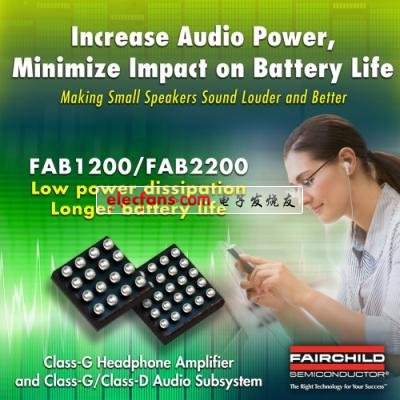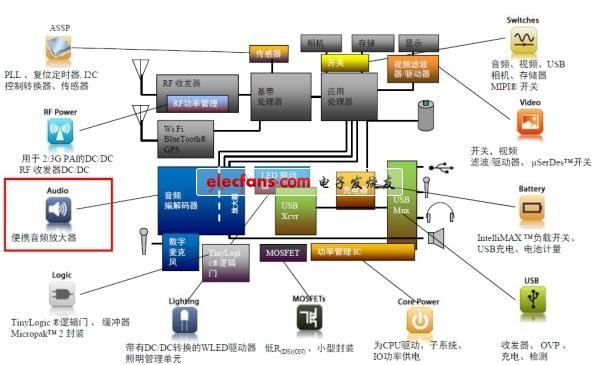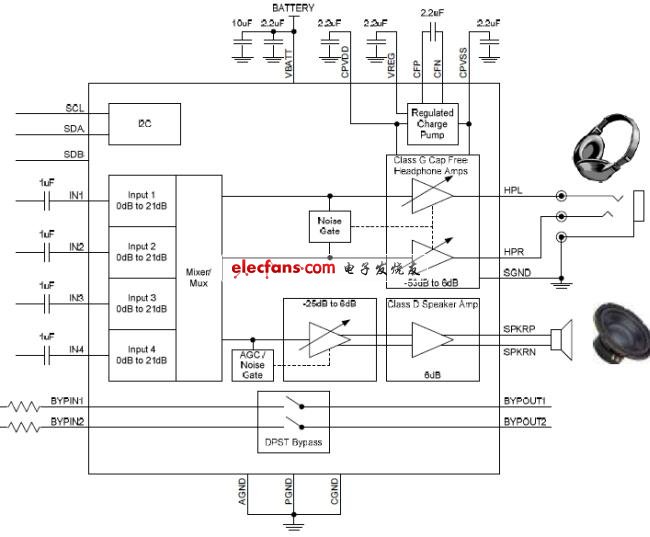"From the point of view of the products exhibited this year, the hotspots in the portable field are smartphones and tablets." Li Wenhui, senior marketing manager of Fairchild Semiconductor, pointed out, "However, as the product design becomes more user-friendly, the functions become more and more Power consumption has become a major difficulty faced by mobile phone manufacturers. For example, today's mobile phone battery capacity has doubled from the past, but the standby time has been shortened by 2-3 times. "
Li Wenhui said, "In the past, most of our energy-saving designs have focused on the three links of RF and power amplifiers , multimedia application processors, and LED backlights, but the increasingly stringent power consumption requirements have made audio systems the next energy-saving design goal. "The power of the audio part accounts for about 12% of the power budget of ordinary smartphones. By improving the design, it can effectively help improve audio quality and reduce the impact on battery life.
Therefore, smartphone and tablet manufacturers have high expectations for audio IC suppliers: they must have advanced audio processing capabilities, high-performance boost design, cost-saving CSP packaging, and low-power audio ICs to be able to simultaneously Meet the high requirements for clearer audio, louder speakers, small footprint and long battery runtime. However, louder audio usually affects battery life and improves distortion; extending battery life usually affects volume; distortion control affects sound quality and battery life. Fairchild Semiconductor has developed a booster amplifier with advanced speaker protection, advanced audio processing technology, audio codec, packaging technology, and a class G amplifier to replace the mainstream class AB amplifier. Good balance.
Since acquiring a portable audio company in 2009, Fairchild has continuously expanded its new products with higher output power, dynamic range compression, speaker protection, improved signal-to-noise ratio, distortion control, and power management by providing differentiated value-added Portable audio products to meet consumer demand.
The company's latest portable audio IC solution can make small speakers louder and clearer. The two new products include the FAB1200 stereo Class-G ground-referenced headphone amplifier with integrated buck converter, and the stereo Class-G headphone amplifier and 1.2W Class-D mono speaker amplifier FAB2200 audio subsystem. Li Wenhui pointed out that compared with the traditional class AB amplifier, the advantage of the class G amplifier is that it can change the operating voltage according to the size of the sound source, but its structure is complex, and the response speed when switching and how to prevent interference are key issues. Fairchild's new products use its proprietary technology to achieve fast two-way switching, its signal-to-noise ratio (SNR) is 106dB, power supply anti-interference ability (PSR) is 77dB (speaker) and 94dB (headphone) Compared with MP3, it has better efficiency than Class-AB in the range of common audio sources.

Figure 1: Fairchild's FAB1200 stereo Class-G headphone amplifier / FAB2200 Class-G / Class-D audio subsystem.
The FAB1200 features a charge pump capable of generating a negative supply voltage, which allows the headset to be ground-centered (ground-centered) output without the need for capacitors, can save up to two external capacitors. The device uses an integrated inductive buck regulator to connect directly to the battery, and adjusts the supply voltage between two different levels based on the output signal level, thereby reducing power consumption. This feature can effectively reduce system cost and extend battery life, while maintaining a high level of audio quality.
The FAB2200 is an audio subsystem that combines a capacitorless stereo Class-G headphone amplifier and a Class-D speaker amplifier. This solution uses a proprietary integrated charge pump to generate multiple power rails to provide a grounded centered Class-G headphone output. Compared with the Class-AB design implementation, the new product can significantly reduce power consumption while providing a high power supply rejection ratio.

Figure 2: Fairchild Semiconductor has a long history in the field of mobile phone products.
The filterless Class-D amplifier can be directly connected to a speaker, eliminating the need for two external filter networks, thereby reducing the overall system cost. The device also has an automatic gain control (AutomaTIc Gain Control, AGC) function, which can limit the maximum output level of the speaker to protect the speaker and prevent the introduction of distortion. It also limits the amplitude dynamically when the battery voltage drops.

Figure 3: FAB2200 audio subsystem (headphone + speaker amplifier) ​​block diagram.
The FAB1200 and FAB2200 portable audio ICs can make the sound quality of mobile phones, tablets / MIDs and other portable audio application products louder and clearer, while reducing the overall system cost and minimizing the impact on battery runtime. "Our goal is to help mobile phone suppliers improve power consumption efficiency and increase the functionality of the product itself." According to Li Wenhui, among the top five mobile phone manufacturers in the world, smart phone products using FAB2200 have begun to ship, and FAB1200 is also being Under evaluation. "I believe that in high-end smartphones and tablets, Class-G amplifiers will become the mainstream in the market, and most of the low-end products below 1,500 yuan will still use Class-AB amplifiers." He finally emphasized.
For more exciting exhibitions, please see: Special Topics of the 2011 Portable Product Innovation Technology Exhibition
The spinning pole is the use of foreign advanced spinning equipment,forming a whole without welding,forming a conical or profiled bar.And then polishing,remove surface oil,burr and indentation.Then after the quenching intensity,to T6 state,in line with international standards.The product never rust ,strong corrosion resistance,diversified surface treatment process,the appearance of simple fluid lines.Light weight and convenient installation and transportation,the rod body can be 100%recycling,low melting temperature.

Product features
â‘ Using spinning equipment advanced,the whole forming a non welding
â‘¡Product permanent does not rust,corrosion resistance
â‘¢Diversified surface treatment technology,make the appearance line succinct smooth
â‘£The light weight,convenient installation and transportation
⑤The rod body can be 100% recycling,melting temperature is low.
Aluminum Alloy Spinning Lighting Pole
Aluminum Alloy Spinning Lighting Pole,Lightest Aluminum Alloy,Aluminum Alloy Torchlight,Lightweight Aluminum Alloy
Jiangsu chengxu Electric Group Co., Ltd , https://www.satislighting.com